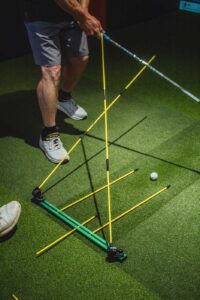Tour Aim 2.0 Review: Is This Alignment Tool Worth $149?

Birdie Score
Price
149.95
One-Putt Summary
The Tour Aim 2.0 transforms chaotic range sessions into structured practice, but you're essentially paying premium prices for a precision-drilled wooden block and rebranded driveway markers.
Fairways (Pros)
- ✓ Putting functionality
- ✓ Fast set up
- ✓ Stable
Hazards (Cons)
- ✗ Super expensive for what it is
- ✗ Limited swing plane angles
Best For
Dedicated Improver with Money
Tour Aim 2.0 Review: Is This Swiss Army Knife of Alignment Tools Worth $90?
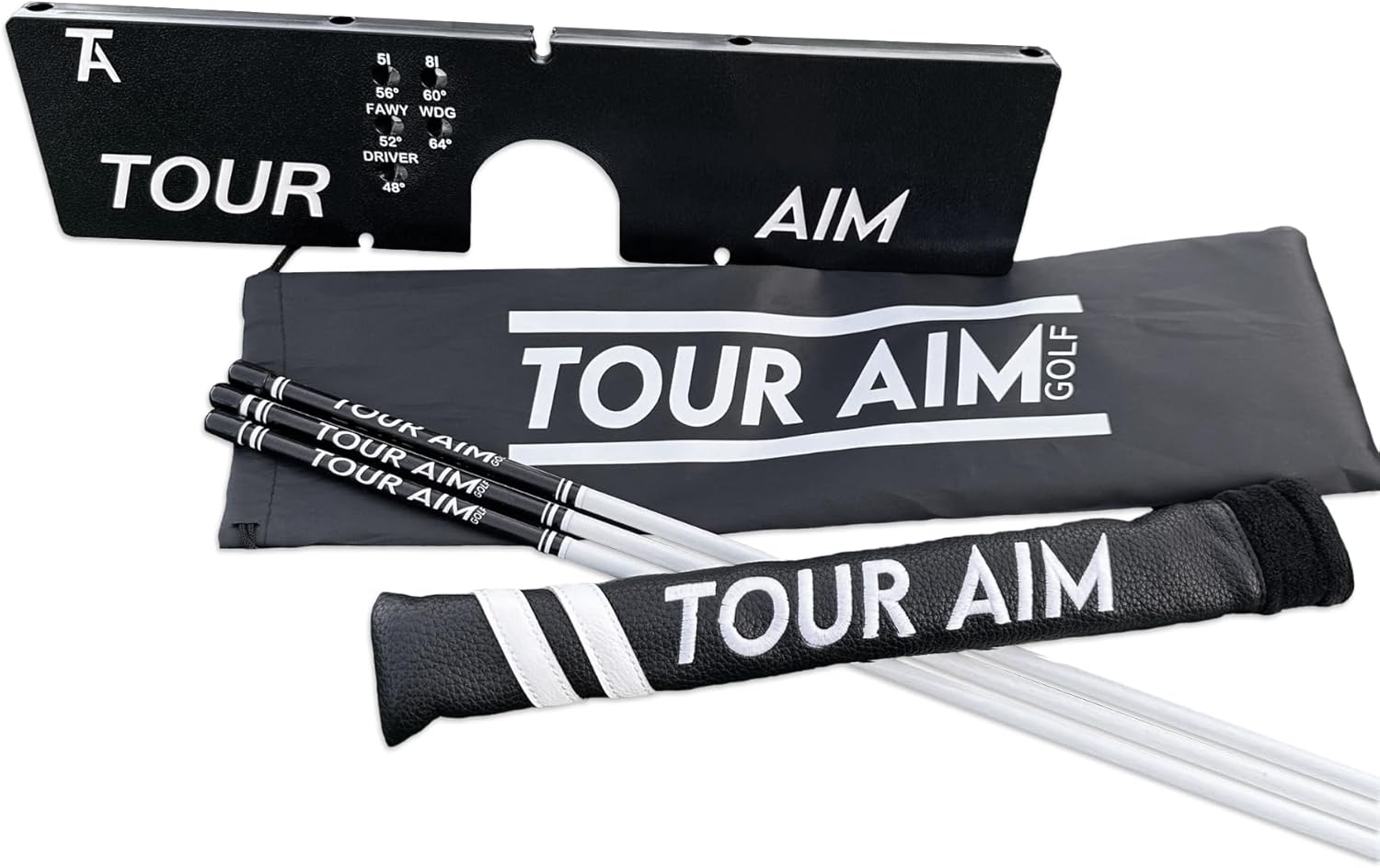
What Is Tour Aim 2.0 and What Does It Actually Do?
Let’s cut through the marketing speak. The Tour Aim 2.0 is a 6×3-inch wooden block with seven strategically drilled holes. That’s it. But here’s the thing – those holes transform standard alignment sticks (think: $2 driveway markers) into a comprehensive practice system.
Tour pros like Max Homa, Justin Rose, and Charley Hoffman use it. It won back-to-back Golf Digest Best Training Aid awards. Elite instructor Sean Foley openly endorses it: “If you struggle with alignment, and you probably do, checkout Tour Aim. This product is fantastic, and I’m not getting paid to say that.”
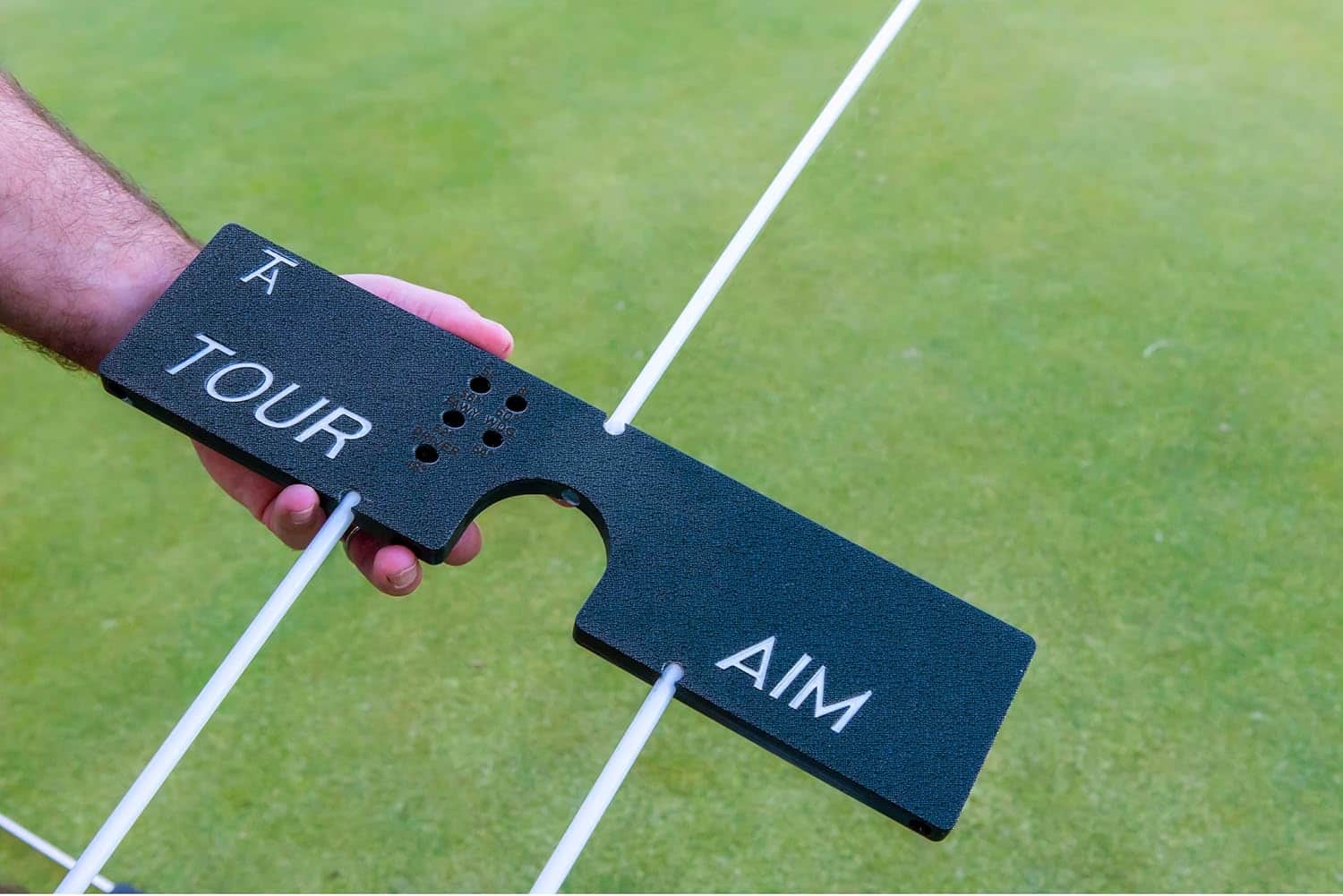
The company claims it’s the “Swiss Army Knife” of golf training aids. Here’s what it actually delivers:
Full-swing alignment training
Seven holes let you set up alignment sticks perfectly parallel to your target line. The center stick aims directly at your target, eliminating the usual “guess-and-check” frustration.
Swing plane correction
Five top holes are angled 48-64 degrees for different clubs (Driver, Fairway, 5-Iron, 8-Iron, Wedge). You elevate one stick to create a visual plane reference to shallow your downswing.
Putting gate drills
A 2.25-inch semi-circle cutout (roughly half a regulation hole) creates a brutal but effective gate for start-line training.
Short game work
Narrow stick placement provides instant feedback on chip and pitch swing paths.
Does it work? User consensus says yes – with caveats. The 92% five-star rating reflects genuine effectiveness for golfers struggling with aim and consistency. But as one Reddit user bluntly stated: “Tour Aim 2.0: Overpriced and not worth it – wouldn’t buy again.” The price-to-value debate is fierce.
Build Quality and Durability: Can This Wooden Block Survive Your Practice Sessions?
The main baseplate is solid. I’m talking “hit it with a 3-wood during a thin shot and it survives” solid. Multiple users confirmed the wooden block shows ball marks but no structural damage after accidental club strikes. It’s made from premium plastic similar to football helmet material – lightweight (1 pound) but surprisingly robust.
Portability is genuinely excellent. The device folds flat to 10.5″ x 3.5″ x 0.75″ and slips easily into your golf bag’s side pocket. One user noted: “It is permanently in my bag with my tripod” after using it for months. The included leather headcover protects the alignment sticks during transport.
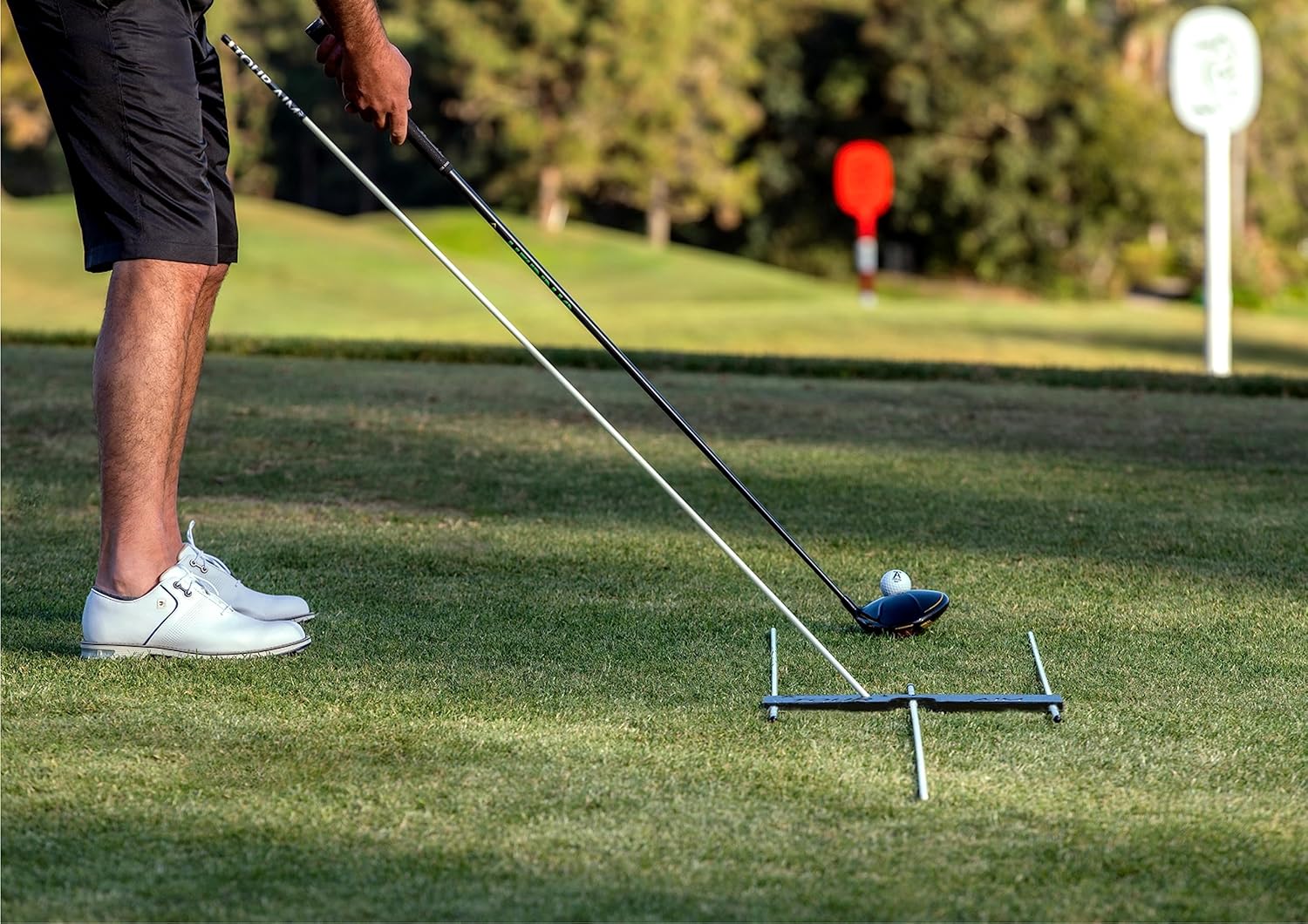
The Durability Reality Check
✓ What holds up:
The main wooden baseplate is virtually indestructible. Users report it surviving 3-wood impacts with only cosmetic ball marks – no cracks, warping, or hole degradation.
✗ What doesn’t:
The Tour Aim+ adapter breaks. Repeatedly. One user: “I broke my adapter on the very first time I used it while hitting driver.” The torque from driver impact on the tee causes frequent failures.
The good news? Tour Aim’s customer service immediately ships free replacements, often same-day. Multiple users praised this warranty support. One received a “re-designed unit” after their first one failed, suggesting the company is actively addressing the issue.
Surface compatibility is legit universal. Grass, turf, hitting mats, carpet, concrete – users confirm it works on everything. A Michigan golfer specifically purchased it for winter garage practice: “Practicing inside has its own set of challenges, especially with alignment… the Tour Aim will be put to use immediately.”
Compatibility Note
Some alignment sticks with fixed plastic caps on both ends won’t fit the holes. Most standard 5/16″ sticks work fine, but you might face a “tough fit” with certain brands. The included sticks avoid this problem entirely.
Build Quality & Durability Score
Excellent baseplate, problematic adapter; saved by warranty
14/20
Effectiveness: Does It Actually Fix Your Swing (Spoiler: Not Exactly)
Here’s where we separate marketing claims from reality. Tour Aim 2.0 doesn’t fix swing mechanics. It fixes practice structure. That’s a crucial distinction.
What it solves immediately:
Alignment deficiency is the plague of mid-handicap golf
You unknowingly aim 5-15 yards left or right during practice, building flawed muscle memory. Tour Aim removes this variable instantly. Users consistently report: “It takes me about 2 seconds, and I know I’ve got perfect alignment.”
One MyGolfSpy reviewer who dropped from 25 to 3 handicap stated: “One area I consistently struggle with in my game is alignment… I’m often guilty of mindlessly hitting balls.” After two weeks with Tour Aim: “I am starting to see an improvement in my swing path.” Note that gradual timeline – not an instant fix.
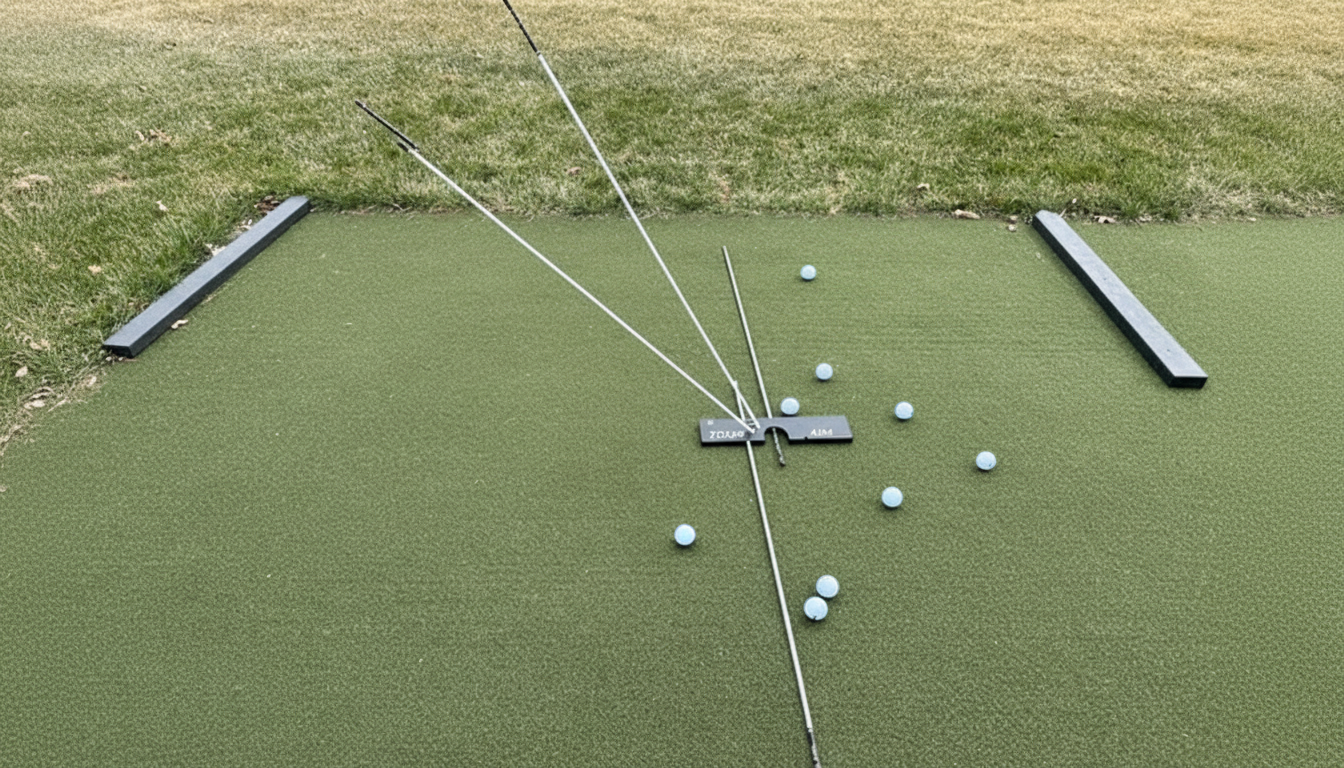
The over-the-top correction:
The swing plane feature provides visual and physical feedback for shallowing your downswing. Users report success, with one noting it “helped shallow out my swing tremendously.” But this requires understanding proper swing plane mechanics first. Without instruction, you’re guessing which of the five holes to use.
The putting gate revelation:

This emerged as the unexpected champion feature. Users who bought Tour Aim for full-swing work discovered the 2.25″ putting gate is brutally effective. One review: “What a PERFECT tool. This will 100% help my putting. Honestly probably best golf aid I have ever used.”
Why does it work so well? It demands precision (the gate is roughly half a regulation hole) and provides instant visual feedback. Plus, it’s integrated into the tool you already have set up for full-swing practice. That convenience factor eliminates the “activation energy” problem that plagues standalone putting aids gathering dust in your garage.
What’s conspicuously missing:
Launch monitor data
Despite extensive research across 180+ sources and the product’s 5+ year market presence, zero users posted Trackman or FlightScope numbers showing measurable attack angle or club path improvements. This absence is notable.
Tour Aim guarantees “immediate improvement in your range sessions” – note they promise range improvement, not course performance. The range-to-course transfer question remains unanswered in verified user reviews.
Bottom line on effectiveness:
Tour Aim delivers verified instant range benefits through structured practice and visual reference. It transforms how you practice, not what swing you have. Lasting mechanical changes and on-course scoring improvements require simultaneous work on fundamentals with proper instruction.
Effectiveness Score
Transforms practice structure; mechanical improvements unverified
18/30
Value for Money: The $149 Question That Divides the Golf Community
Let’s talk about the elephant on the range. Tour Aim 2.0 costs $75-150 (depending if you want the baseplate only or starter pack). You’re paying premium prices for a precision-drilled wooden block and three fiberglass sticks that are functionally identical to $2 driveway markers from Home Depot.
Tour Aim 2.0
$75-149
(with discount code)
Blue Brick
$169
(competitor)
DIY Alternative
$5-10
(driveway markers)
The DIY alternative is real and it works
Reddit users confirm: “The alignment sticks themselves are essentially fiberglass driveway markers.” For swing plane drills, flip over a range bucket to prop up a stick. For putting gates, use two tees. Total cost: $5-10.
So why does Tour Aim have a 92% five-star rating if it’s “overpriced”?
Why Users Pay the Premium Anyway
The dedicated practitioners who praise Tour Aim cite these justifications:
The convenience premium
Tour Aim delivers 2-second setup versus 3 minutes of manual stick placement and adjustment. That time savings compounds over dozens of practice sessions. For golfers practicing 3+ times weekly, that efficiency matters. For once-a-month range visitors, it absolutely does not justify the cost.
The multi-functionality argument
Unlike single-purpose aids, Tour Aim genuinely works for full swing, short game, and putting. Teaching pro Robert Linville states: “I use Tour Aim in my setup for every lesson. Wouldn’t teach without it.” That breadth of application means you get value across every practice session.
The warranty wild card
Tour Aim’s customer service consistently earns praise. Same-day replacement shipments for broken parts, responsive emails, redesigned units when issues surface – this post-purchase support adds real value that DIY solutions can’t match.
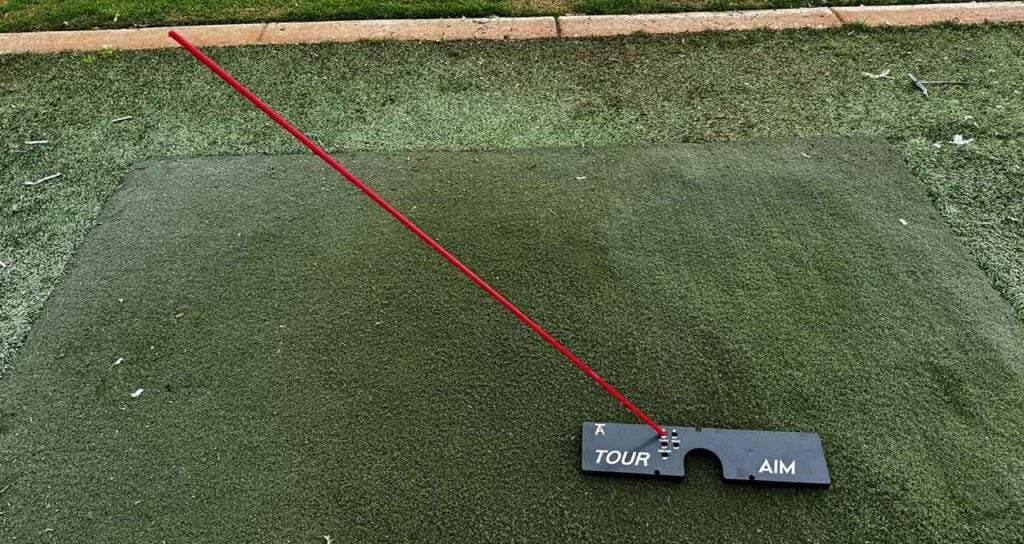
Worth it if you:
- • Practice 3+ times weekly
- • Value time savings
- • Struggle with alignment
- • Want indoor practice capability
- • Can afford $90-120 without financial stress
Skip it if you:
- • Practice casually (less than weekly)
- • Already align well
- • Prefer spending $5-10 on DIY alternatives
- • Expect mechanical swing fault correction
- • Need pre-round warmup tools
One touring professional summed it up: “For what it does for you on the Range it’s really good, is just a little bit overpriced… I’d call this A tier… All Things Considered it’s pretty convenient.”
Value for Money Score
Justified for frequent practitioners; expensive vs. alternatives
11/25
Ease of Use: 2-Second Setup, 2-Hour Learning Curve
✓ Plug-and-Play Basic Setup
The basic alignment function is genuinely plug-and-play. Insert sticks, aim center stick at target, done. User consensus: “It takes about 2 seconds.” Even beginners find the primary alignment setup intuitive.
✗ Swing Plane Learning Curve
The swing plane feature, however, demands homework. One user noted: “Will take a learning curve with the club selection process. Difficult to get lessons that accurately tell you where for example to place the plate and sticks.”
You’ll need to watch multiple tutorial videos or consult with an instructor to understand which of the five holes to use for your specific swing and club. Without that guidance, you’re essentially guessing which angle is correct for your swing plane.
Smart Move by Tour Aim
The company includes a free CoachNow online lesson (valued at $129) with purchase, which helps bridge this knowledge gap. It acknowledges that the tool works best when paired with expert guidance.
Portability & Surface Compatibility
| Weight & Size | 1 pound, sits flat to 10.5″ x 3.5″ x 0.75″ – fits easily in golf bag side pocket |
| Surface Compatibility | Works identically on grass, turf, mats, carpet, and concrete – truly universal |
| Left-Handed Setup | Simple 180-degree rotation of baseplate (though marketing could be clearer) |
| Pre-Round Warmup | Impractical – too slow for typical 15-20 minute warmup routines |
Portability is a genuine strength. The device weighs 1 pound and folds flat to fit easily in your golf bag’s side pocket. Multiple users report keeping it permanently in their bags for immediate use. The included carry pouch and leather headcover protect the unit and sticks during transport.
Zero physical discomfort reported. Unlike impact bags, weighted clubs, or posture-restricting devices, Tour Aim causes no body pain, clothing damage, or injury. It’s purely a visual reference system.
Ease of Use Score
Lightning basic setup; swing plane feature needs instruction
13/20
Versatility: Multi-Tool Excellence
Real-World Applications
- ✓ Full swing alignment training (primary use)
- ✓ Swing plane correction for over-the-top fixes
- ✓ Putting gate drills for start-line accuracy
- ✓ Short game path feedback for chips and pitches
- ✓ Indoor/outdoor year-round practice capability
- ✓ Pre-lesson and post-lesson reinforcement work
Unlike single-purpose aids, Tour Aim genuinely works for full swing, short game, and putting. Teaching pro Robert Linville states: “I use Tour Aim in my setup for every lesson. Wouldn’t teach without it.” That breadth of application means you get value across every practice session, not just when working on one specific skill.
Versatility Score
Genuinely multi-functional across all practice scenarios
4/5
Fairways & Hazards: The Honest Breakdown
Fairways (Strengths)
- ✓ Lightning setup eliminates practice friction – 2-second alignment vs 3-minute manual placement
- ✓ Putting gate delivers unexpected championship-level value – MVP feature for many users
- ✓ True multi-surface versatility – grass, mats, carpet, concrete all work identically
- ✓ Customer service exceeds industry standard – same-day replacements, no hassle
- ✓ Permanent bag residency – actually light enough to keep with you always
Hazards (Limitations)
- ✗ Price-to-function gap drives legitimate criticism – $90-120 vs $5-10 DIY alternatives
- ✗ Zero quantifiable performance data after 5+ years – no launch monitor numbers posted
- ✗ Swing plane feature demands professional guidance – not plug-and-play for self-teachers
- ✗ Tour Aim+ adapter durability is genuinely problematic – breaks on first use for many
Best For: The Dedicated Improver Profile
Tour Aim 2.0 delivers maximum value for golfers who:
The MyGolfSpy reviewer who dropped from 25 to 3 handicap exemplifies this profile: “One area I consistently struggle with in my game is alignment… I’m often guilty of mindlessly hitting balls. My hope is that the Tour Aim will provide some easy-to-set-up checkpoints.” He practices regularly, understands his alignment weakness, and values efficiency.
Skip This If You:
- ✗ Practice less than once weekly (insufficient use frequency to justify the cost)
- ✗ Are budget-focused and comfortable with $5-20 DIY driveway marker alternatives
- ✗ Are a complete beginner without alignment knowledge or instructor guidance
- ✗ Are a scratch golfer or advanced player who already maintains consistent alignment habits
- ✗ Expect mechanical swing fault correction or quantifiable launch monitor improvements
- ✗ Are a minimalist who prefers simple tools without integrated accessories
- ✗ Only play courses without practicing between rounds (on-course-only golfers)
Frequently Asked Questions
Can I just use $2 driveway markers instead of Tour Aim 2.0?
Does Tour Aim 2.0 work for left-handed golfers?
Will this fix my slice or over-the-top swing?
Is the putting gate feature actually useful or just a gimmick?
How durable is the Tour Aim+ adapter? I’ve seen reviews saying it breaks.
Can I use Tour Aim 2.0 for pre-round warmups?
Does Tour Aim 2.0 work on all practice surfaces?
Will my existing alignment sticks fit in Tour Aim 2.0?
How does Tour Aim 2.0 compare to the Blue Brick training aid?
Do I need the Tour Aim+ adapter or just the base unit?
The Bottom Line: A Premium Practice Organizer, Not a Swing Mechanic Miracle
Tour Aim 2.0 is a legitimately effective training tool that succeeds at transforming chaotic range sessions into structured, purposeful practice. The 92% five-star rating across 121+ verified reviews reflects genuine user satisfaction, not marketing manipulation. Tour pros use it. Elite instructors endorse it. Golf Digest awarded it back-to-back Best Training Aid recognition. The product delivers on its core promise.
But let’s be clear about what you’re buying: a precision-drilled wooden block and rebranded driveway markers for $90-120. The value proposition depends entirely on how you practice golf.
Tour Aim excels at:
- • Eliminating alignment guesswork in 2 seconds
- • Preventing mindless ball-beating through constant visual feedback
- • Providing brutally honest putting gate training
- • Working identically across all surfaces
- • Living permanently in your golf bag at 1 pound
Tour Aim fails at:
- • Justifying its premium price for casual golfers
- • Providing quantifiable swing mechanic improvements
- • Offering plug-and-play swing plane training
- • Delivering adapter durability
The purchase decision ultimately hinges on two questions:
- 1. Do you practice 3+ times weekly? If yes, the time savings and convenience premium is justified. If no, DIY alternatives deliver 70% of the functionality for 10% of the cost.
- 2. Do you value structured practice systems over raw function-per-dollar? If yes, Tour Aim’s integrated design encourages consistent use in ways loose sticks don’t. If no, you’ll forever resent paying $90 for a wooden block.
For the dedicated improver – the 8-20 handicapper practicing multiple times weekly, struggling with alignment, working with instruction – Tour Aim 2.0 earns its place as a permanent practice companion. It improves how you practice, which indirectly improves your game.
For the casual player or DIY-minded golfer – the once-a-month range visitor or pragmatist who sees a wooden block and fiberglass sticks – the value proposition collapses. Buy driveway markers and save $85.
Final Scoring Breakdown
| Category | Score | Max |
|---|---|---|
| Effectiveness | 18 | 30 |
| Build Quality & Durability | 14 | 20 |
| Ease of Use | 13 | 20 |
| Value for Money | 11 | 25 |
| Versatility | 4 | 5 |
| TOTAL | 60 | 100 |
Solid “C+” Training Aid
Final Verdict: 70/100
A genuinely useful practice organizer hampered by premium pricing and unverified on-course performance claims. Worth buying if you practice frequently and value efficiency. Overpriced if you don’t.
⛳ The 19th Hole: Final Verdict
The Tour Aim 2.0 transforms chaotic range sessions into structured practice, but you're essentially paying premium prices for a precision-drilled wooden block and rebranded driveway markers.
Birdie Score: 60/100

